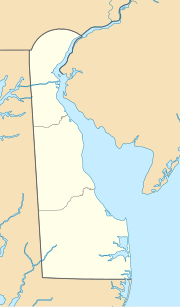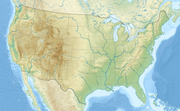Stallion Head Branch
Appearance
| Stallion Head Branch Tributary to Gum Branch | |
|---|---|
| Location | |
| Country | United States |
| State | Delaware |
| County | Sussex |
| Physical characteristics | |
| Source | Johnson Branch divide |
| • location | about 1.5 miles southeast of Staytonville, Delaware[2] |
| • coordinates | 38°49′32″N 075°30′02″W / 38.82556°N 75.50056°W[1] |
| • elevation | 50 ft (15 m)[2] |
| Mouth | Gum Branch |
• location | about 0.75 miles southwest of Oakley, Delaware[3] |
• coordinates | 38°49′25″N 075°30′02″W / 38.82361°N 75.50056°W[1] |
• elevation | 38 ft (12 m)[3] |
| Length | 2.16 mi (3.48 km)[4] |
| Basin size | 1.26 square miles (3.3 km2)[5] |
| Discharge | |
| • location | Gum Branch |
| • average | 1.38 cu ft/s (0.039 m3/s) at mouth with Gum Branch[5] |
| Basin features | |
| Progression | Gum Branch → Nanticoke River → Chesapeake Bay → Atlantic Ocean[4] |
| River system | Nanticoke River |
| Tributaries | |
| • left | unnamed tributaries |
| • right | unnamed tributaries |
| Bridges | Century Farm Road, DE 16, Oak Road |
Stallion Head Branch is a 3.16 mi (5.09 km) long 1st tributary to Gum Branch in Sussex County, Delaware. This is the only stream of this name in the United States.[1]
Course
[edit]Stallion Head Branch rises about 1.5 miles southeast of Staytonville, Delaware[2] and then flows south to join Gum Branch about 0.75 miles southwest of Oakley, Delaware.[3]
Watershed
[edit]Stallion Head Branch drains 1.26 square miles (3.3 km2) of area, receives about 45.4 in/year of precipitation, has a topographic wetness index of 757.38 and is about 4% forested.[5]
See also
[edit]References
[edit]- ^ a b c "GNIS Detail – Stallion Head Branch". geonames.usgs.gov. US Geological Survey. Retrieved 4 December 2020.
- ^ a b c "Get Maps". USGS Topoview. US Geological Survey. Retrieved 4 December 2020.
- ^ a b c "Get Maps". USGS Topoview. US Geological Survey. Retrieved 4 December 2020.
- ^ a b "ArcGIS Web Application". epa.maps.arcgis.com. US EPA. Retrieved 4 December 2020.
- ^ a b c "Stallion Head Branch Watershed Report". US EPA Geoviewer. US EPA. Retrieved 4 December 2020.


